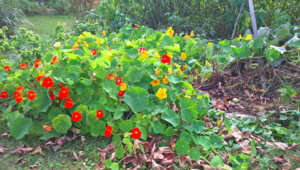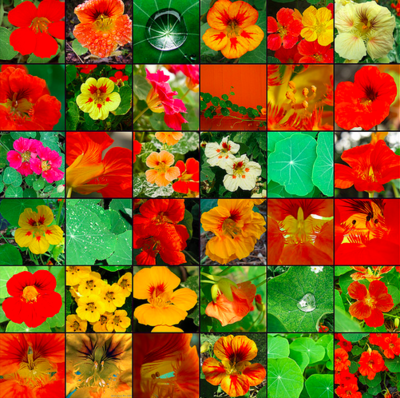
Nasturtium (Tropaeolum sp.) are treated as both an annual herb and flower.[1] Nasturtiums can be grown in poor soil. Indeed, if planted in rich soil, they produce more leaves than flowers. Once the plant begins to flower, it should continue to flower all through summer, adding vibrancy to a garden.
Description[edit | edit source]

Nasturtiums can be compact or small bush-like (Tropaeolum minus) or trailing (Tropaeolum majus) in form.[1]
The flowers bloom in summer and are orange, yellow, red or mixed in colour. The leaves are rounded in shape and are either a medium to dark green or variegated.
Growing nasturtiums[edit | edit source]
Nasturtium can be grown from seed or seedlings, in garden beds or in containers. Seeds are very easy to plant and can be sown in a garden patch, edging or on embankments with ease. Seedlings don't transplant as well as might be liked, so it's recommended that you prefer seeds unless there is no choice. Seed germination can be boosted by soaking in water overnight before planting.[1]
Select soil that is average to poor in nutrients. The nasturtium likes a full sun aspect and it is important to wait until the frosts are definitely over before planting; these flowers need warm and dry conditions to grow well.
Plant the seed 10mm / 1/2 an inch deep in the soil. Keep the seed bed moist but not water logged. Once the seedlings have appeared and are strong, thin to about 15 to 30cm / 6 to 12 inches apart.
Ongoing care for nasturtiums[edit | edit source]
Nasturtiums don't need a lot of input from the gardener. However, if you'd like to give them a boost to bloom profusely, mulch well and water regularly during hot weather. This will encourage more flowers.
If they're already in the vegetable garden, as opposed to a less fertile part of the garden, don't expect too many flowers.
Problems[edit | edit source]
Nasturtiums are fairly hardy. They can attract some pests though, such as aphids. This tendency is used by some gardeners to decoy the aphids onto the nasturtiums, after which the devastated plant is removed and destroyed, along with its inhabitant aphids.
While the nasturtium will tolerate slight shade, shadiness often reduces flowering.[1]
Uses of nasturtiums[edit | edit source]
Nasturtiums look good in the garden. Their leaves are interesting (like little waterlily pads) and their flowers are pretty. They can form part of edible landscaping (see culinary uses next).
Nasturtiums can be used in for culinary purposes (as a herb), such as using the flowers and/or leaves in salads, egg dishes, vinegars, potatoe dishes, etc..[2][1] Both the flowers and the leaves have a spicy flavour (like watercress).[1] Be aware that the spiciness increases with heat and lowered water levels while growing; if you want mild spiciness, water the plants well and regularly.[1] Younger leaves are more tender and tasty.
The flower buds and immature seed pods can be used in place of capers. They need to be pickled first.
Nasturtiums are used in companion planting. Scientifically, you can have a bet both ways as to whether or not nasturtiums deter pests as both results have been found in various trials!